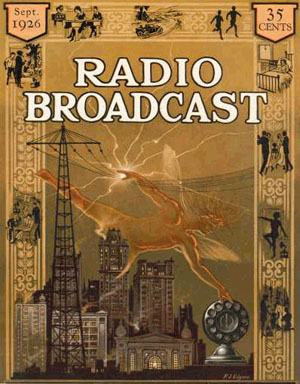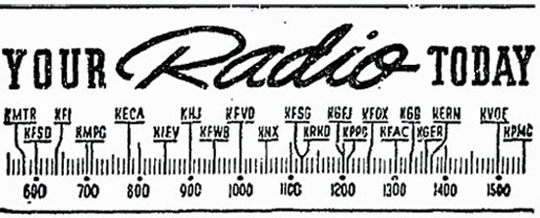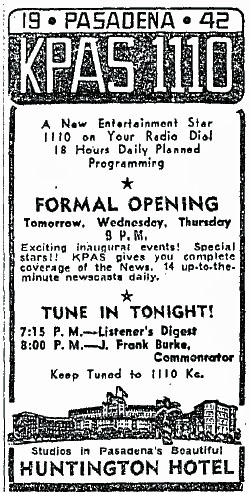KRLA and the Beat history
KRLA personalities
KRLA specialties
Early history: KPAS 1110

Those of us who grew up with top forty formats in the 1960s were used to the Los Angeles market roiling from competition between the Big Two (initially KFWB and KRLA) and starting in 1965 the Big Three, with a third contender, KHJ, added into the mix. But decades earlier the airwaves were filled with a different sort of sublime noise.
In 1922 when the flying god of the airwaves first cavorted through the skies of Los Angeles, all stations shared approximately the same place on the radio dial, 485 meters (about 620 kilocycles in in later terminology). This led to problems, not surprisingly.
Stations were supposed to play nice with each other and broadcast their programs for only a portion of the day, then graciously sign off and let the next station step up to the plate. Angry letters to the editor of the Los Angeles Times suggest that the listening public was not well served by this strategy.
One listener complained that when he settled down to tune in Frances St. George on her ukelele at her assigned time, her recital was overrun not five minutes later by another station tuning up early with The Tooth Paste Troubadors and their dance-music program. Separate frequencies were inevitable.Both KHJ and KFWB, KRLA's future rivals, were part of the early radio scene in Los Angeles. KHJ, originally around 740 on the dial, went on the air in 1922 and was at first owned by the Los Angeles Times. Warner Brothers' station KFWB debuted in 1925 at about 1200 kilocycles, broadcasting from towers situated at Warner Brothers' Studios. Gradual frequency adjustments placed KFWB at 980 and KHJ at 930, where the stations aired variety shows and news programs through the decades.

So who was at 1110 while the local airwaves were percolating with sound? No one, at least not in the Los Angeles market. The radio dial looked like this (right) in 1940. KFWB and KHJ were not quite situated at their eventual frequencies. Look carefully: KMPC is not in two places at once. One is KMPC, one is KPMC.

In 1942 KPAS appeared at 1110 on the dial (left) with its on-air compatriots. KFWB and KHJ are now at 980 and 930. KPAS was established by John Franklin Burke, a former attorney, Ohio state senator, and newspaper publisher in Emyra and Bucyrus, Ohio. Burke relocated to Southern California in 1927 as co-publisher of the Santa Ana Register, along with his son-in-law Loyal King (formerly Loyal Herman Kletzian of New Horizon, Wisconsin). Burke was also associated with at least two radio stations in the 1930s, KREG in Santa Ana at 1500 KC, and KFVD at 1020 KC in various Southern California cities (it moved around a lot), including Culver City, Venice, and eventually the Wilshire District. KFVD eventually morphed into KPOP and KGBS, but that was long after Burke's ownership of the station.
KPAS was a new venture, headed by Burke and Loyal K. King (Loyal Kletzien) who was also Burke's son-in-law, plus transmitter engineer Jack Reeder, who built the transmitter and towers in South El Monte on North Lexington-Gallatin Road. The studios were located in upscale Pasadena at the Huntington Hotel at 1401 South Oak Knoll. Under the auspices of Pacific Coast Broadcasting, KPAS delivered a mix of music, religious programs, political chat, and gave air time to country-western music-makers such as Jimmy Wakley and His Rough Riders, Johnny Bond, and Asher & Jimmy.
KPAS was never a major presence on the Los Angeles airwaves, nor was it a moneymaker for its owner, having procured no national network ties such as KNX and KECA. The latest reference found for KPAS is November 3, 1945 from a Los Angeles Times advertisement for a church service which aired every Sunday. Change was in the air.

KXLA popped up at 1110 in the January 5, 1946 radio guide (right) and remained so until September 1959, when as KRLA it began delivering the same top forty tunes as KFWB, a format described by the Pasadena Independent newspaper as "inane popular songs, frantic news bulletins, twist dance tunes and light-headed disc-jockey chatter." Good enough for rock-and-roll!
What was KPAS like?

Sharp-eyed readers of this particular issue of the Los Angeles Times might have noted history being made. Nestled next to a reminder to obey your air-raid warden ("So if the guy next door is a warden, you'd better be nice to him") was a small advertisement for a new radio station.
Even in those days the station that would become KRLA had a devotion to news, and station owner J. Frank Burke had his own commentary each evening at 8:00pm. But KPAS had competition from its compatriots on the dial. 1960s nemesis KHJ "at 930 on your dial" had the Raymond Gram Swing Show scheduled from 7:00 to 7:15pm, KECA (later KABC) offered Erskine Johnson's "Hollywood Spotlight", and on KMPC the Native Sons sponsored Frank Watanabe's talk on "The Japanese Menace."
But KPAS had a roster of inviting shows of its own, including "Meet Priscilla Alden" at 10:30am (sounds like a soap opera), "Let's Play Bridge" with Ray Noll at 2:45pm, J. Newton Yates at the organ at 10:30pm (poor fellow was probably in studio every week night for this, audiotape not yet being widely available), and "Problem Clinic" with Don Wilkie on Sunday nights at 8:45pm.
In terms of profit, KPAS was foundering in the ether. It seemed inevitable that the station would be sold to the highest bidder, and that bidder was inclined to change the call letters to KXLA as well as altering the format to something known at the time as Western Swing.